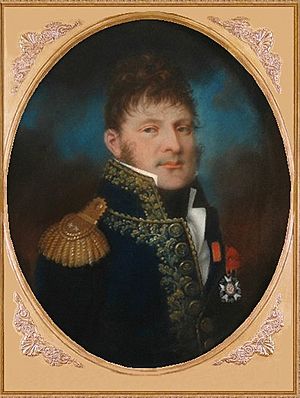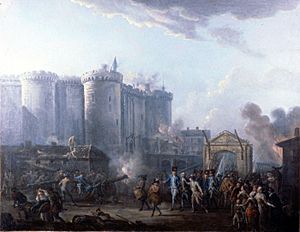Pierre-Augustin Hulin facts for kids
Quick facts for kids
Pierre-Augustin Hulin
|
|
|---|---|

portrait miniature of Hulin
|
|
| Born | 6 September 1758 Paris, France |
| Died | 9 January 1841 (aged 82) Paris, France |
| Allegiance | |
| Years of service | 1771-1815 |
| Rank | General de division |
| Commands held | Military governorship of Paris 1st Division |
| Battles/wars | Siege of Genoa |
| Awards | Legion of Honor |
Pierre-Augustin Hulin (born September 6, 1758 – died January 9, 1841) was a French general. He served under Napoleon Bonaparte. Hulin was involved in important events like the storming of the Bastille. He also played a role in the trial of the Duke d'Enghien. Later, he helped stop the Malet coup, an attempt to overthrow the government.
Contents
Early Life and the French Revolution
Pierre Augustin Hulin was born in Paris, France, in 1758. His father was a fabric seller. Hulin joined the army in 1771. He served in an infantry regiment and later in the French Guards. He became a sergeant. By 1787, he had left the army and was running a successful laundry business.
Before the storming of the Bastille in 1789, Hulin spoke to crowds. He encouraged people to protest against the king. One famous writer, Madame de Staël, said Hulin wanted to get revenge for her father. Others recorded him telling soldiers that Parisians were being "slaughtered like lambs."
The Storming of the Bastille
On July 14, 1789, the day the Bastille prison was stormed, Hulin offered his help. He gathered about seventy men and five cannons. Around 3 PM, he led his group to the Bastille. Two hours later, the prison's governor, Marquis de Launay, decided to surrender. The attackers had lost about 100 men, while only one defender died.
Hulin and his helper, Jacob Elie, tried to protect De Launay from the angry crowd. They sent him with guards to the Hôtel de Ville, a city hall. But the crowd eventually got past the guards. De Launay was killed by a cook. Another official, Jacques de Flesselles, was also killed. However, most of the Bastille's defenders were safely taken to the Hôtel de Ville.
The day after the Bastille fell, Hulin was made a company commander. His group was called the Volontaires de la Bastille. This group was paid by the city and later became part of the National Guard. Hulin became a national hero for his actions. People saw him as a strong leader.
After the Revolution
Many noble officers left the army during the French Revolution. New officers were promoted from the regular soldiers. However, Hulin was arrested during the Reign of Terror, a time of great political violence. He was held for almost a year, from 1793 to 1794. When the radical government fell in 1794, Hulin was set free.
During the French Revolutionary Wars, Hulin fought in the Army of Italy. He fought against the Austrians in the defense of Genoa. He also commanded troops in Milan. He rose through the ranks and became a colonel.
Service Under Napoleon
Hulin served under Napoleon Bonaparte, who became the leader of France. Hulin worked as a chief of staff in different army divisions. Later, he commanded the grenadiers, a special group of soldiers, in Napoleon's guard. In August 1803, Hulin was promoted to brigadier general.
The Duke d'Enghien Trial
In 1804, Hulin led the group that put Louis Antoine, Duke of Enghien on trial. The Duke was from a royal family related to the old kings of France. He was accused of treason. The Duke was found guilty and executed. This event caused anger and shock in other European countries.
Military Governor of Paris
Hulin fought in Napoleon's main army, the Grande Armée, in campaigns in 1805 and 1806. He fought in what is now Germany. After the campaign in Prussia, he was given command of troops in Berlin. In 1807, he was promoted to major general. He was also made the military governor of Paris. He held this important job until 1814 and again in 1815.
In 1808, Hulin was given the title of Count of the Empire. In 1809, he received a high honor called Grand Officer of the Legion of Honor.
Stopping the Malet Coup
In 1812, Hulin was still the military governor of Paris. At this time, Napoleon was fighting a difficult war in Russia. A general named Claude François de Malet tried to take over the government. Malet's loyal troops arrested many of Napoleon's officers in Paris.
When Hulin tried to arrest Malet, Malet shot him in the face. But Hulin's resistance made other troops and police turn against Malet. Malet was then arrested. Malet and others involved in the plot were executed. Hulin was rewarded for his bravery with command of the 1st Division.
Later Years
When Napoleon gave up his power, the new king, Louis XVIII, took away Hulin's command. But when Napoleon returned from exile in 1815, Hulin got his position back. However, after Napoleon's final defeat, Hulin lost his command again. The new government sent Hulin away from France for a time. He was allowed to return to France in 1819.
Pierre-Augustin Hulin died in Paris on January 9, 1841.
Images for kids
-
Oil painting by Jean Baptiste Lallemand depicting the arrest of the Marquis de Launay, the governor of the Bastille. Either the soldier or the grey-clad civilian next to Launay may be Hulin (Musée de la Révolution française).
Sources
- Philip J. Haythornthwaite (2001). [Napoleon's Commanders (1) 1792-1809]. Osprey Publishing. ISBN: 1-84176-055-2.
- Hans-Jürgen Lüsebrink, Rolf Reichardt (1997). The Bastille: a history of a symbol of despotism and freedom. Duke University Press. ISBN: 0-8223-1894-6.
- Robert Warren (2000). Jacques-Louis David and Jean-Louis Prieur, revolutionary artists: the public, the populace, and images of the French Revolution. SUNY Press. ISBN: 0-7914-4288-8.
See also
 In Spanish: Pierre-Augustin Hulin para niños
In Spanish: Pierre-Augustin Hulin para niños




